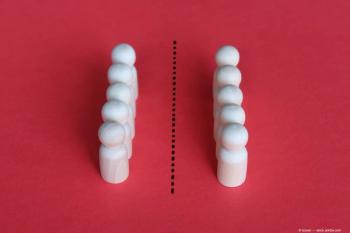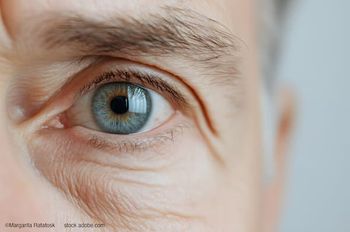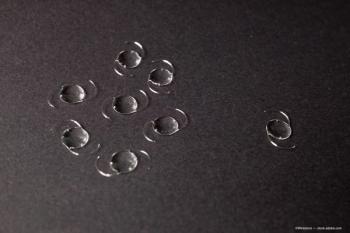
What role does chromatic aberration play in IOLs?
White light is comprised of different wavelengths of visible light, ranging from red (700 nm) to violet (400 nm). As white light passes through an optical system, each of its component wavelengths bends independently.
White light is comprised of different wavelengths of visible light, ranging from red (700 nm) to violet (400 nm). As white light passes through an optical system, each of its component wavelengths bends independently.
By Snell’s law, faster-moving longer wavelengths bend less than slower-moving shorter wavelengths, dispersing the various colors to different focal points along the optical axis.
This dispersion is referred to as longitudinal chromatic aberration (LCA). The impact of LCA is thought to be greater than the impact of all higher-order aberrations1, but its effect on IOLs or on pseudophakic vision has not been well characterized.
The Abbe number can be used to quantify LCA in optical materials. Based on Abbe number calculations, the phakic eye has a baseline LCA of about 1.25 D of chromatic refractive difference between red (650 nm to 700 nm) and blue (450 nm) light.2 In pseudophakic eyes, the IOL implanted can potentially increase or decrease the eye’s LCA relative to the phakic state, depending on the properties of the IOL.
Unfortuntaely, Abbe numbers are not made publicly available by IOL manufacturers. Additionally, the effects of chromophores and diffractive patterns on LCA have not been published. A study presented at the 2016 Association for Research in Vision and Ophthalmology (ARVO) meeting attempted to further characterize LCA in IOLs, through in vitro optical bench and in vivo clinical testing.3
Bench testing
To explore the amount of ocular LCA of different IOLs in vitro, five intraocular lenses made from two different hydrophobic acrylic materials were placed in an ACE model eye on an optical bench. The ACE (Average Cornea Eye) aphakic eye model simulates a human cornea with average spherical aberration (SA) and LCA.4
Through-focus modulation, transfer-function (MTF) measurements were performed using a 3.0-mm aperture. Measurements were performed at five different wavelengths: 450 nm, 500 nm, 550 nm, 600 nm, and 650 nm. LCA was expressed as the difference in optical power for the different wavelengths.
Figure 1: Chromatic aberration over the range of 450 nm to 650 nm expressed in diopters in the spectacle plane. The dashed line represents the aphakic eye model chromatic aberration of 1.04 D. Courtesy of Daniel H. Chang, MD
LCA of the aphakic eye model was 1.04 D (Figure 1). The first hydrophobic acrylic material had LCA of 1.30 D (Tecnis, Johnson & Jonson Vision Care/Abbott Medical Optics), and the second hydrophobic material had LCA of 1.77 D (Acrysof, Alcon Laboratories).
The presence of a chromophore did not significantly affect LCA. Multifocal diffractive rings did not affect the LCA at the far focal point, but an achromatic diffractive ring pattern significantly reduced LCA as measured in vitro.
This study demonstrated that in a physiologically representative eye model the chromatic aberration of IOLs can be measured and varies widely for different IOL materials.
However, bench testing is insufficient to fully understand optical quality because it is such a pure measure. It is difficult to accurately model the imperfections of the human eye-and impossible to model all the complex factors that go into the human visual system, including higher order aberrations, ocular surface, and retinal factors; emotions, moods, and fatigue; and the ability of the brain to compensate for aberrations, interpret visual stimuli, and interpolate visual information.
In vivo testing
A second test was devised to evaluate LCA clinically. This is a challenge, because there is no ophthalmic diagnostic device that measures chromatic aberration. Therefore, a chromatic refraction technique was developed to characterize the impact of LCA on pseudophakic vision.
In this prospective clinical pilot study, 23 patients were implanted with a Tecnis ZCB00 lens in one eye and an Acrysof SN60WF lens in the fellow eye. The SN60WF lens does have a chromophore, but bench top testing indicated that the chromophore does not affect LCA.
At 30 to 60 days after the second-eye surgery, chromatic refractions were performed. To do this, a white light manifest refraction was performed using a standard high-contrast Snellen chart to correct for any residual refractive error.
Then, using a larger optotype (e.g., the 20/50 line), the chart was covered with a 650-nm red filter and the sphere was readjusted. The same was done with a 450-nm blue filter, and all three numbers were recorded.
The difference between the red and blue refractions is the chromatic refractive difference. Note that the limitations of available color filters significantly reduced the overall brightness of the eye chart, although contrast was slightly enhanced by the red filter.
Figure 2: Median difference in refraction under mesopic conditions when refracted using the blue filter and the red filter. The bars represent the mean and standard error of the mean of 23 patients. Courtesy of Daniel H. Chang, MD
In vivo measurements with the ZCB00 lens resulted in a difference in refraction between the red and the blue color filter of 1.12 D in photopic conditions and 1.11 in mesopic conditions. With the SN60WF lens the chromatic refractive difference was 1.28 in photopic conditions and 1.30 in mesopic. The difference between the two materials under mesopic conditions was statistically significant (Figure 2).
It is very interesting that in vivo measurements correlate with optical modeling and bench testing. The lens material with higher LCA in bench testing indeed resulted in a greater chromatic refractive difference in the clinical study. This validates both the in vitro model as well as the in vivo testing technique.
More studies needed
Further studies are needed to understand the clinical significance of chromatic refractive differences. Low-contrast sensitivity and glare situations might be affected by LCA and chromatic refractive differences.
The human visual system can tolerate a significant amount of monochromatic aberrations, but it is unclear how much LCA can be tolerated. Nevertheless, it has generally been the goal with refractive and/or cataract surgery to reduce-or at least not add to-those aberrations.
In summary, chromatic aberration is a fundamental property of IOLs. Techniques and methods of measuring and assessing the clinical effects of LCA are still being developed, but this pair of studies represent important steps forward in characterizing LCA in pseudophakic lens materials.
References:
1. Zhai Y, Wang Y, Wang Z, et al. Construction of special eye models for investigation of chromatic and higher-order aberrations of eyes. Biomet Mater Eng 2014;24(6):3073-81.
2. Zhao H, Mainster MA. The effect of chromatic dispersion on pseudophakic optical performance. Br J Ophthalmic 2007;91:1225-9.
3. Chang DH, Weeber HA, Lowery MD, Piers PA. Chromatic aberration of intraocular lenses measured in vitro and in vivo, ARVO 2016.
4. Terwee T, Weeber H, van der Mooren M, Piers P. Visualization of the retinal image in an eye model with spherical and aspheric, diffractive, and refractive multifocal intraocular lenses. J Refract Surg 2008;24(3):223-32.
Daniel H. Chang, MD
P: 661-325-3937
Dr. Chang is in private practice at Empire Eye and Laser Center in Bakersfield, CA. He is a consultant to Abbott Medical Optics.
Newsletter
Don’t miss out—get Ophthalmology Times updates on the latest clinical advancements and expert interviews, straight to your inbox.



















































.png)


